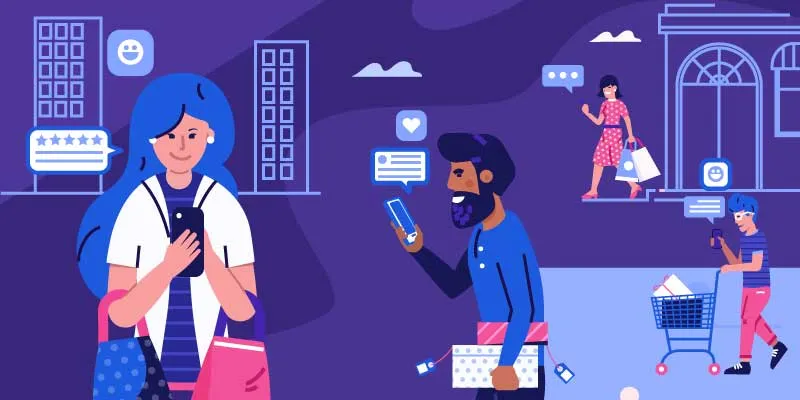Post-purchase experience is a critical step towards customer loyalty
With retailers being the go-to for many customers, it is important to have a good returns policy and personalised service to shop virtually.
A young woman makes plans to join a friend on a shopping spree in the weekend. She has an important wedding to attend and urgently needs to update her wardrobe. The popular mall is her best bet and she goes on a relentless retail spree to find what she needs. After a highly disappointing experience, as she either cannot find the right size or style, she almost gives up. She likes one outfit but alas, it’s not available in her size. Her friend whips out her smartphone to check the availability of the same dress, online. Yes, her size is available!

The Indian shopper has clearly moved to online retail shopping platforms, owing to convenience, options and better deals. This has given a huge boost to the online shopping category. As the market continues to grow, ecommerce players are faced with myriad challenges owing to strong competition, lack of product differentiation, overheads and timely delivery. There are so many options that a customer can choose from and the competition is very close. Further, with global players in the fore, smaller retailers really need to up their game.
Let’s look at the key challenges in the customer online shopping journey. Today, customers prefer an option to track their order delivery schedule over other features like product recommendations, loyalty points and benefits. The bottom line is that customers are looking for an effortless and transparent experience. They expect to hear from online retailers not only before they buy, but after as well. Our recent report states that 56 percent consumers are unhappy with the lack of visibility that retailers provide on their order delivery status - not knowing if their order will arrive on the promised date or not having an option to track their delivery order status on demand. Hence, it is imperative for companies to understand the critical nature of this touchpoint in making or breaking customer loyalty.
?fm=png&auto=format)
According to a Narvar consumer report in 2018, 52 per cent customers sought an easy online return solution – one of the main drivers to shop online. The advent of immersive technologies has paved the way for virtual shopping - digital capabilities evolve to provide consumers with increasingly personalised experiences with the help of predictive analytics. One can simply order online, and digital assistance will help understand what exactly the requirements are of an individual, basis which he or she may get suggestions in terms of category, size, colour, etc. As brands continue to iterate and refine their digital strategies, it’s clear that personalisation is a defining factor in customer satisfaction - customer support plays a vital role in a user’s e-commerce journey. All the way from awareness and interest, to retention and upsell, customer support is spread widely across the whole customer journey.
Retailers need to understand what customers do, and what are their requirements - tailor support experiences accordingly. Also, technology has ensured that people are always connected – either through systems or smart devices. Moving between real and virtual worlds has become easy and customers constantly shift between both. Many companies fail in bridging the gap between the actual sale and post purchase customer experience. Given the demand, companies have started to see the utility of post purchase customer experience, in building loyalty and engagement for their respective brands. They ensure regular interaction with customers, provide them visibility into a time frame and delivery status of their products, and ensure high quality content for customer satisfaction.
Narvar’s data indicates:
o 83 percent shoppers say they expect regular communication about their purchases.
o 53 percent shoppers won’t purchase something if they don’t know when it will arrive.
o 54 percent will give repeat business to a retailer that can predict when a package will arrive.
Returns policies, and how returns are handled, are key concerns for online retailers - it can be a major headache at times. There’s the cost of processing returns, in terms of staff and resources, and there’s also the risk that items returned may not be easily resold. To make sure customers get what they want, more and more consumers buy multiple versions of an item, trying them on at home, and initiating online clothing returns for the ones that don’t work—a shopping style known as bracketing.
1564558863273.png?fm=png&auto=format)
A recent survey stated that many shoppers say that they bracket at least some of their online purchases. This leaves retailers facing more returns than ever before. But as they say, if you can’t beat them, join them. And that’s exactly what retailers have done: In response to rise of bracketing, a growing number of companies have begun offering “Try-Before-You-Buy” (TBYB) programmes, which invite customers to try items at home without making them pay anything upfront. Shoppers are only charged for the items they don’t send back, offering a more elegant and customer-friendly solution than bracketing.
So, what does a company not being ready to implement TBYB mean? For starters, one can minimise bracketing by analysing return reason data and using these insights to inform fit and colour recommendations during the consideration phase. If customers can predict how an item will work out for them, they won’t need to order multiples to figure out what they need. One can also work on removing friction from the returns process. Shoppers can be accommodated by implementing a returns platform that helps manage returns, collect returns data and recapture sales with a branded interface easily and seamlessly.
In fact, returns are an opportunity to create a competitive advantage. After all, 96 percent customers say that they’ll become repeat customers of a retailer that can provide an easy returns process. And with the right returns’ solution, one can make it simple for customers to make additional purchases while completing a return. That’s great news for retailers trying to improve their returns process. With the right tools, they can turn returns into the thing that makes customers come back for more.
The shipping and delivery solutions space in India has seen tremendous growth with the boom in ecommerce. Over the past few years, there have been quite a few delivery companies that have emerged, that cater to the unique needs of the ecommerce business. Some have emerged to become dominant players in this space. However, most solutions are all focused on improving operational efficiency and less on enhancing customer experience.
Ensuring a great post-purchase customer experience is hence important and is not just a thing – it is now one of the key elements required for a successful business. The ability to allow and help customers to interact seamlessly with a company (between online channels and digital and real world) is the underlying premise of a high-level customer experience. Therefore, retailers must strive to offer such experiences to its customers and bridge the gap between customer expectations and service – this will possibly help gain customers’ loyalty that will in turn, last for a lifetime.
The writer is a spokesman for Narvar India.
(Disclaimer: The views and opinions expressed in this article are those of the author and do not necessarily reflect the views of YourStory.)
(Edited by Suruchi Kapur)









